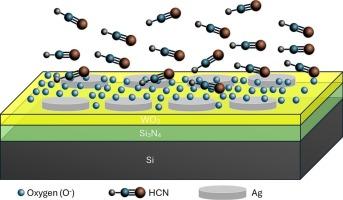基于三氧化钨(WO3)纳米片的微热板气体传感器用于检测化学战剂模拟物
IF 4.9
2区 化学
Q1 CHEMISTRY, ANALYTICAL
引用次数: 0
摘要
在这项研究中,基于原始和银(Ag)负载的三氧化钨(WO3)纳米片开发了微型热板化学气体传感器,并对其用于检测化学战剂(CWA)模拟物进行了比较评价。采用水热法在铂微热板平台上直接合成了WO3纳米片。x射线衍射(XRD)结果表明,WO3为正交相。扫描电镜(SEM)分析证实了WO3的致密纳米片状形貌,能谱(EDS)分析证实了WO3形成的原子比为W/O ~ 25% / 75%。使用射频磁控溅射技术将WO3样品功能化为标称厚度为10 nm的Ag层(~ 2.5% wt.)。制备的传感器对CWA模拟剂进行了测试,包括氰化氢(HCN)、硫化氢(H2S)、2-氯乙基硫化氢(2-CEES)、甲基膦酸二甲酯(DMMP)、二丙二醇单甲基醚(DPGME)和磷酸三甲基(TMP)。Ag负载提高了对HCN的灵敏度和选择性,在1 ppm时的响应为27.70,而原始WO3的响应为6.93,而响应时间为112 s。性能的提高是由于HCN分子与WO3表面Ag位点之间的特定相互作用,提供了一种独特的响应机制。与之前报道的对有毒气体有广泛或非特异性反应的研究相比,这项工作首次证明了通过银纳米颗粒修饰的HCN选择性的急剧增强,使其非常适合作为靶向CWA检测。这些结果强调了Ag负载对气体选择性的影响,为设计针对特定气体检测应用的基于WO3的传感器提供了一种策略方法,并强调了其实时CWA检测的潜力。本文章由计算机程序翻译,如有差异,请以英文原文为准。

Micro-hotplate gas sensor based on tungsten trioxide (WO3) nanoflakes for detecting chemical warfare agent simulants
In this study, micro-hotplate chemiresistive gas sensors based on pristine, and silver (Ag) loaded tungsten trioxide (WO3) nanoflakes are developed and comparatively evaluated for detecting chemical warfare agent (CWA) simulants. WO3 nanoflakes are synthesized directly on a platinum (Pt) micro-hotplate platform via hydrothermal method. X-Ray diffraction (XRD) results show the orthorhombic phase of WO3. Scanning electron microscopy (SEM) analysis proves the dense nanoflake morphology of WO3, while Energy dispersive spectroscopy (EDS) analysis proves the formation of WO3 with atomic ratio of W/O ∼ 25 % / 75 %. WO3 samples are functionalized with a nominal thickness of 10 nm Ag layer (∼2.5 % wt.) using RF magnetron sputtering. The fabricated sensors are tested against CWA simulants, including hydrogen cyanide (HCN), hydrogen sulfide (H2S), 2-chloroethyl ethyl sulfide (2-CEES), dimethyl methylphosphonate (DMMP), dipropylene glycol monomethyl ether (DPGME), and trimethyl phosphate (TMP). Ag loading enhances sensitivity and selectivity toward HCN, achieving a response of 27.70 at 1 ppm compared to 6.93 for pristine WO3, while the response time is observed as 112 s. The improved performance is attributed to specific interaction between HCN molecules and Ag sites on the WO3 surface, providing a distinct response mechanism. Compared to previous studies that have reported broad or non-specific responses toward toxic gases, this work demonstrates for the first time a sharp enhancement in HCN selectivity through Ag nanoparticle decoration, making it highly suitable as a targeted CWA detection. These results highlight the impact of Ag loading on gas selectivity, offering a strategic approach for designing WO3 based sensors tailored for specific gas detection applications and emphasizing its potential for real-time CWA detection.
求助全文
通过发布文献求助,成功后即可免费获取论文全文。
去求助
来源期刊

Microchemical Journal
化学-分析化学
CiteScore
8.70
自引率
8.30%
发文量
1131
审稿时长
1.9 months
期刊介绍:
The Microchemical Journal is a peer reviewed journal devoted to all aspects and phases of analytical chemistry and chemical analysis. The Microchemical Journal publishes articles which are at the forefront of modern analytical chemistry and cover innovations in the techniques to the finest possible limits. This includes fundamental aspects, instrumentation, new developments, innovative and novel methods and applications including environmental and clinical field.
Traditional classical analytical methods such as spectrophotometry and titrimetry as well as established instrumentation methods such as flame and graphite furnace atomic absorption spectrometry, gas chromatography, and modified glassy or carbon electrode electrochemical methods will be considered, provided they show significant improvements and novelty compared to the established methods.
 求助内容:
求助内容: 应助结果提醒方式:
应助结果提醒方式:


